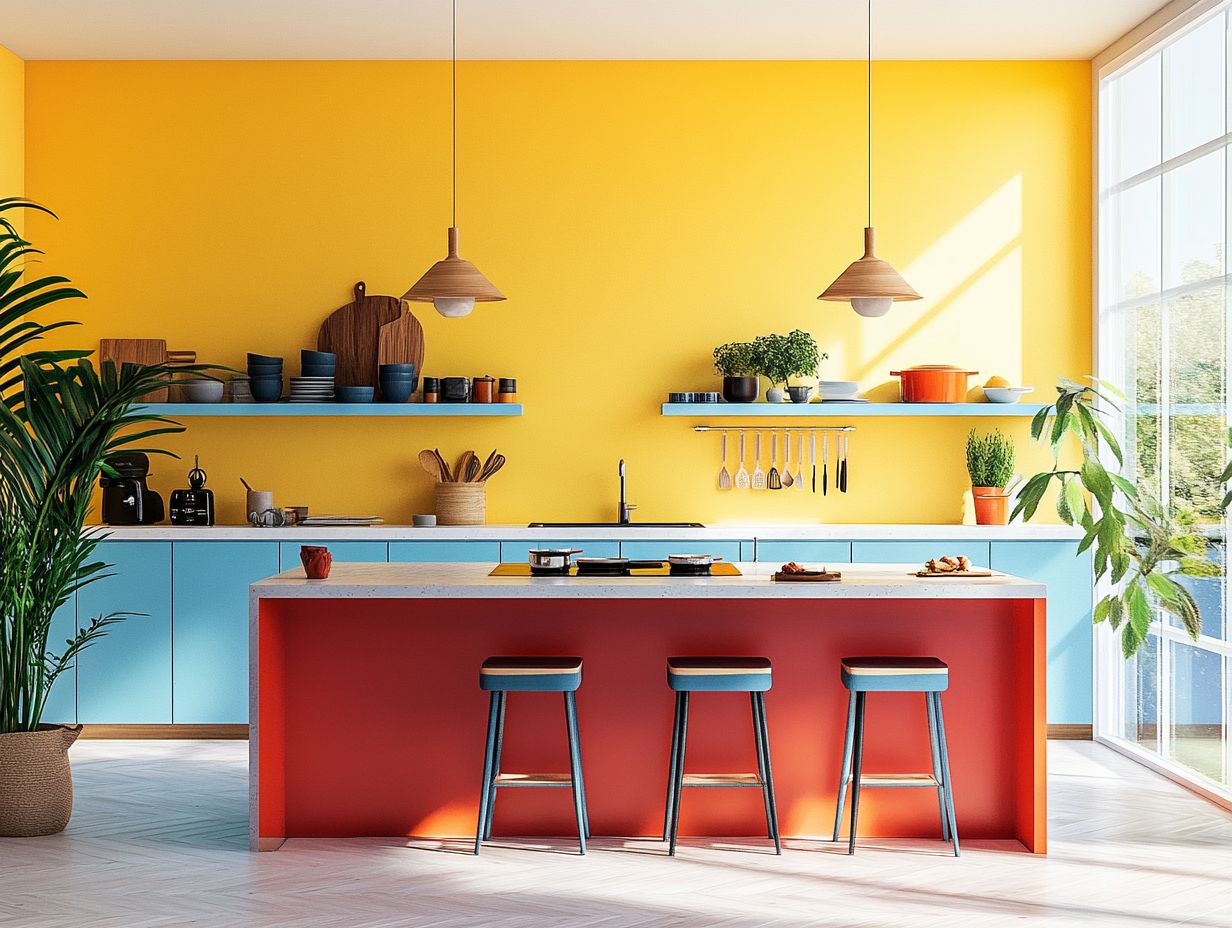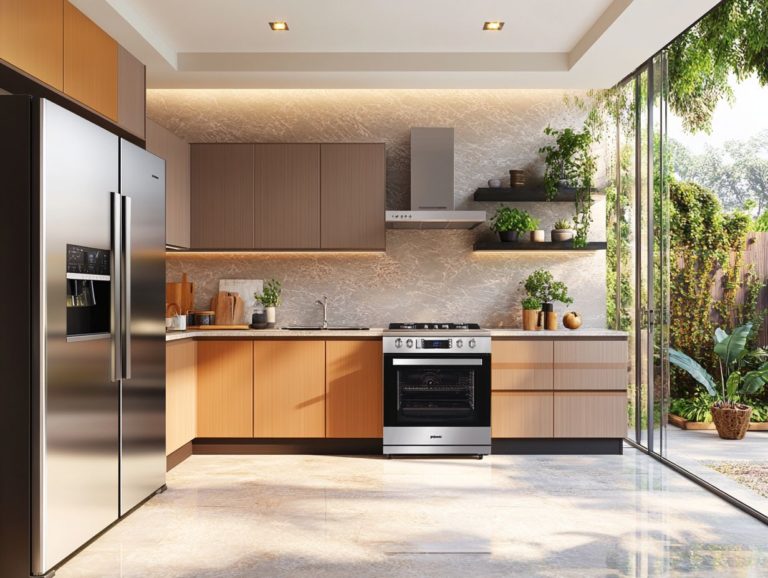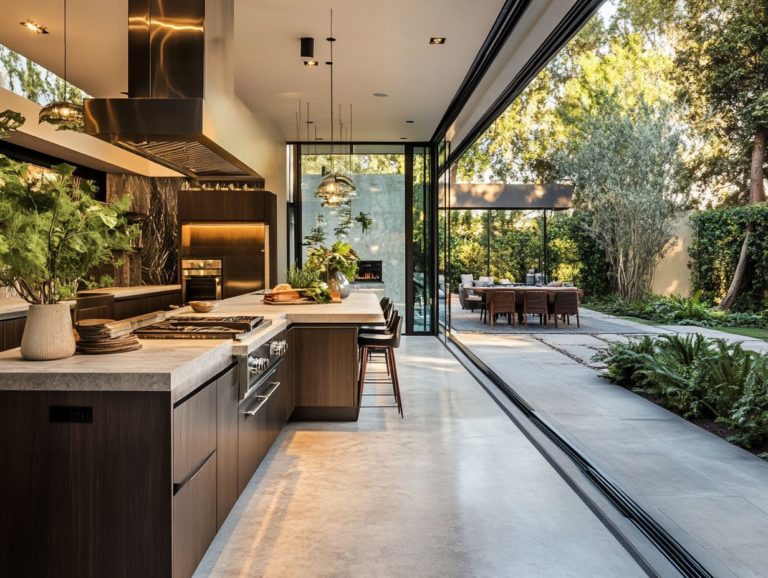5 Ways to Use Color in Kitchen Design
Transforming your kitchen can be an exciting journey, not a daunting task. By incorporating bold and vibrant colors, you can breathe new life into the heart of your home.
This guide presents five creative ways to infuse color into your kitchen, from daring cabinets to eye-catching appliances and accessories.
Prepare to ignite your imagination!
Contents
- Key Takeaways:
- 1. Use a Bold Color for the Cabinets or Island
- 2. Add a Pop of Color with Appliances or Accessories
- 3. Incorporate Colorful Backsplash or Countertops
- 4. Use Colorful Lighting Fixtures
- 5. Create a Colorful Accent Wall
- How Can Color Impact Kitchen Design?
- Frequently Asked Questions
- What are 5 ways to use color in kitchen design?
- How can a colorful backsplash enhance a kitchen design?
- Why should I consider incorporating colorful appliances in my kitchen design?
- What types of accents can I use to add color to my kitchen?
- Is it a good idea to paint the cabinets a bold color?
- Can I use more than one bold color in my kitchen design?
Key Takeaways:

Bold colors in cabinets or islands add personality and make a statement in kitchen design.
Vibrant appliances and accessories bring a fun touch to the kitchen.
Colorful backsplashes or countertops enhance visual interest and depth in the design.
1. Use a Bold Color for the Cabinets or Island
Using a bold color for your cabinetry or kitchen islands can serve as a striking focal point, improving the kitchen’s look while allowing you to express your personal style. Stunning combinations like deep blue, olive green, and blush pink can elevate aesthetics effortlessly.
Picture this: deep blue cabinets that pop against warm oak countertops, creating a sophisticated yet inviting space. Similarly, olive green cabinets evoke calmness, especially when paired with white-washed shelves or rustic wooden islands.
Two-toned designs, featuring different colors on upper and lower cabinets, beautifully unify the kitchen’s visual appeal while allowing your individuality to shine through.
2. Add a Pop of Color with Appliances or Accessories
A pop of color through appliances or accessories enhances your kitchen’s visual appeal. These vibrant accents blend seamlessly into your overall color palette.
These colors can change the mood of the kitchen, making it feel more inviting. For instance, deep red appliances evoke warmth, while creamy pastels like soft mint or blush pink bring a refreshing aesthetic.
As you embrace open-plan designs, these colors stand out while harmonizing beautifully with neutral cabinetry. Colorful dishware and vibrant textiles can further complement these hues, transforming an ordinary cooking area into a lively hub that reflects your style.
3. Incorporate Colorful Backsplash or Countertops
A colorful backsplash or unique countertops can elevate your kitchen design, introducing textures and patterns that harmonize with your cabinetry.
Materials like marble add a touch of luxury with their distinctive veining. If you want to add depth to your space, consider textured wallpaper as an inviting backdrop that integrates seamlessly with both rustic wood and sleek modern cabinets.
Imagine pairing a warm cream-colored backsplash with deep navy cabinets for stunning contrast, or choosing muted gray wallpaper that softens brighter elements and maintains cohesive flow throughout your space.
Let’s get started on making your dream kitchen a reality today!
4. Use Colorful Lighting Fixtures

Colorful lighting fixtures do more than just brighten your kitchen; they bring it to life and create a warm atmosphere! They play an important role in shaping the ambiance of the space.
By introducing warm tones and vibrant elements, they enhance the overall interior design, making the kitchen feel truly inviting. When you incorporate various styles, like pendant lights or under-cabinet lighting, you create a layered effect that beautifully showcases your cabinetry.
Pendant lights are hanging fixtures that can add style and brightness to your kitchen. For instance, sleek brushed metal fixtures or vibrant ceramic pendants can offer a modern twist, drawing the eye to the kitchen’s aesthetic.
Soft, warm white bulbs work wonders in evoking a cozy atmosphere, turning meal preparations into an inviting experience. Using different colors can harmonize with cabinetry finishes, such as deep blues or rich wood tones, creating a seamless and cohesive look.
Ultimately, well-chosen lighting transforms your kitchen into a welcoming hub for family gatherings and culinary creativity.
5. Create a Colorful Accent Wall
Creating a colorful accent wall in your kitchen is an impactful design choice that gives your kitchen a special feel. It invites layered colors and sophisticated designs into the heart of your home.
When selecting the right color combinations, balance vibrant tones with more subdued shades to achieve a dynamic yet harmonious look. Think about how bold reds, sunny yellows, or deep blues can evoke different moods.
Warm colors can energize the space, while cooler hues offer a sense of serenity. It’s crucial to consider how these accents can serve as focal points, tying together cabinet finishes, countertop textures, and flooring materials.
This will ensure a cohesive aesthetic throughout your kitchen. Understanding the psychological effects of color—how green can create a refreshing atmosphere—can significantly enhance the overall ambiance.
Color psychology is the study of how colors affect our feelings and behaviors. This knowledge makes your kitchen not only stylish but also inviting for everyone who steps inside.
How Can Color Impact Kitchen Design?
Color plays an important role in your kitchen design, influencing not just aesthetics but also functionality and emotional atmosphere. Shades like warm white, neutral tones, and timeless colors evoke feelings of warmth and comfort.
Take shades of blue, for instance—they’re becoming increasingly popular for their calming effects, transforming your kitchen into a serene hub for family interaction. On the other hand, vibrant colors like sunny yellows can inject energy into the space, sparking creativity and encouraging social gatherings.
By understanding the principles of color psychology, you can create inviting environments that not only look stunning but also feel inviting. Thoughtfully selecting hues allows you to establish the desired ambiance.
Whether you envision a cozy nook for your morning coffee or a lively area for hosting friends, the right colors can truly make a difference.
What Are the Best Colors to Use in a Kitchen?
Selecting the perfect colors for your kitchen requires a nuanced understanding of how hues like deep blue, forest green, and soft woods can create harmony and balance. These colors will elevate your space’s aesthetic appeal.
Incorporating these colors will significantly influence the mood and energy within your kitchen. Deep blue, for instance, evokes a sense of calmness and sophistication, making it an ideal choice for cabinetry or feature walls.
Forest green brings a touch of nature indoors, promoting relaxation and balance, particularly in an open layout. Soft woods contribute warmth and texture, crafting an inviting atmosphere that welcomes both family and friends.
When blending these shades, consider the natural light your kitchen receives, as this can dramatically alter how each color presents itself throughout the day.
Lighter shades can brighten a dimmer space, while darker tones can add depth to well-lit areas, creating a cozy and thoughtfully designed kitchen.
How Can Color Be Used to Create a Cohesive Design?

Color serves as a remarkable tool in crafting a cohesive design. Thoughtfully selecting hues for cabinetry, walls, and accents can unify your kitchen space into a sophisticated whole. This is beautifully showcased in popular two-toned kitchen designs.
By choosing a harmonious palette, you create a seamless flow that guides the eye throughout the room. This makes it feel both expansive and inviting.
Consider using complementary colors. Pair warm wood tones with cool blues or greens to enhance the overall aesthetic while adding visual interest.
Be cautious when selecting combinations; the wrong choices can detract from the kitchen’s intended atmosphere.
A well-considered approach to color elevates the beauty of the space and fosters a balanced, functional environment.
What Are Some Common Mistakes When Using Color in Kitchen Design?
In kitchen design, common pitfalls often stem from misjudged color palettes. These missteps can lead to jarring contrasts or an overwhelming application of bold colors, detracting from the space’s harmony and sophistication.
For example, think about a kitchen that skillfully blends soft pastels with natural wood tones. This combination creates a serene atmosphere, contrasting sharply with one that relies on clashing primary colors, resulting in a chaotic feel.
Striking a balance is essential. Utilize a neutral backdrop to introduce accent colors without overwhelming the overall design. A subtle turquoise can beautifully complement white cabinetry, while too many bright hues might leave you feeling unsettled.
Using tools like color wheels and sample boards significantly enhances your ability to visualize combinations, setting the foundation for a kitchen that truly reflects your aesthetic.
How Can Color Be Used to Create Different Moods in the Kitchen?
Color holds remarkable power in shaping the mood of your kitchen. Warm tones and soft whites invite a welcoming atmosphere, while bolder hues inject energy into the space, showcasing the nuances of color psychology in design.
Imagine soft yellows and pastels enveloping your kitchen; they evoke feelings of serenity and cheer, making them perfect for family gatherings and everyday cooking moments.
Conversely, deep blues and greens foster calmness and focus, creating an oasis for the dedicated chef. Pair earthy tones with vibrant accents to achieve a balanced vibrancy that sparks creativity.
Reflect on the emotions each shade evokes. If you cherish warmth, terracotta might be your go-to, while someone drawn to modern aesthetics may prefer cool grays accented with bright pops of color to invigorate their culinary space.
What Are Some Tips for Adding Color in a Small Kitchen?
In a small kitchen, adding color may seem daunting. Yet, using lighter shades paired with vibrant accents can transform the space, creating an illusion of openness while infusing character into the compact area.
To achieve this delicate balance, consider soft hues like pale blues or creamy whites for larger surfaces like walls and cabinets. These shades reflect light beautifully, making your kitchen feel more spacious.
Next, introduce bolder colors through smaller elements—think dishware, rugs, or a feature wall. These accents bring personality without overwhelming the room. Position vibrant colors at eye level to draw attention and cultivate an inviting atmosphere.
Remember, your color choices enhance aesthetics and can influence mood and energy levels while you cook.
Frequently Asked Questions

What are 5 ways to use color in kitchen design?
The 5 ways to use color in kitchen design are:
- Using a colorful backsplash
- Adding colorful appliances
- Bringing in colorful accents through decor
- Painting the cabinets a bright color
- Choosing a bold color for the walls
How can a colorful backsplash enhance a kitchen design?
A colorful backsplash can add a pop of color and texture to your kitchen! It becomes the main attraction, making the space feel vibrant.
It also ties together different design elements, creating a cohesive look.
Why should I consider incorporating colorful appliances in my kitchen design?
Colorful appliances bring personality and interest to your kitchen! They can serve as statement pieces that add a unique touch to the overall design.
What types of accents can I use to add color to my kitchen?
You can use various accents like colorful dishware, kitchen towels, and rugs! Consider adding curtains or a vibrant island to enhance the look.
These accents can easily be changed to refresh your kitchen’s style.
Is it a good idea to paint the cabinets a bold color?
Painting your cabinets a bold color adds drama and surprise to the kitchen! Just ensure that the bold color complements your overall color scheme.
Can I use more than one bold color in my kitchen design?
Absolutely! You can use multiple bold colors for an eye-catching kitchen!
Just balance the colors and choose ones that work well together. Neutral colors can serve as a great base, allowing bold colors to pop!
Ready to transform your kitchen? Start experimenting with color today!





